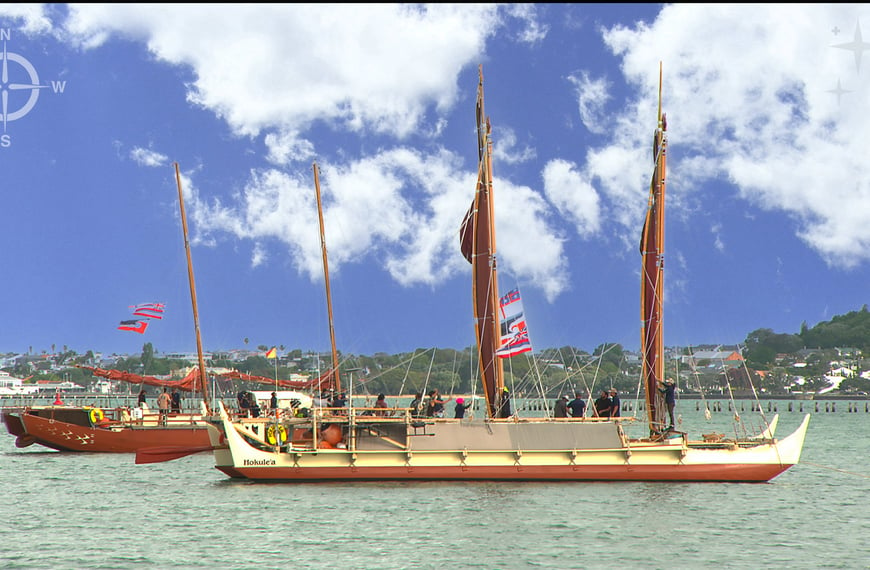
Former journalist and communications specialist Dr Angie Enoka has worked in many roles across the New Zealand civil service over several years. To mark Vaiaso o le Gagana Samoa, Samoa Language Week, she traces her language journey from her homeland in Samoa and how it has fortified her over the years.
In the tapestry of life, I am bound by the sacred threads of service and devotion, guided by the timeless wisdom of my Samoan language and heritage with the profound essence of alofa (love) and tautua (service) that permeates my cultural identity.
O lo’u igoa o Angie Enoka (My name is Angie Enoka)
Na ou fanau i Samoa (I was born in Samoa)
Ou te sau mai nu’u o Togafuafua, Safotu ma Fusi Safotulafai (I come from the villages of Togafuafua, Safotu and Fusi Safotulafai)
Ou te nofo i Ueligitone i le pitonuu o Wairarapa i Saute (I live in Wellington in the South Wairarapa district)
Ou te faigaluega i le Matagaluega o Aoga (I work for the Ministry of Education)
Fa’atalofa atu, Malo le soifua (Talofa and Good health to you)
I was brought up in the village of Togafuafua, about two minutes from Apia, the capital of Samoa on the island of Upolu. I was raised in a strict Catholic household.
We didn’t have much but I was a happy child. Because we lived close to town our house was like the airport transit lounge.
Relatives were constantly stopping by uninvited, and I quickly learned to always welcome everyone with a smile, offer them food and something to drink.
I also learned quickly how to interact with the formal and colloquial Samoan, oratorical register; the respectful (chiefly) vocabulary and the fa’afafine lingo. These are all different styles of my everyday conversation.
My village is bordered on one side with Apia and on the other with the famous mount Vaea, and other closely situated villages.

The streets and houses in many ways remind me of an average colourful South Auckland suburb, though they are each on large, lush sections of flat land with decorated graveyards, with colourful hedges, abounding with frangipani or hibiscus plants.
We had one preschool and one primary school just down the road, both of which are situated on the Catholic church’s land, alongside the pastor’s house.
There are a few shops which sell a range of snacks and drinks and one roadside fruit and vegetable stall, all of which open and close at the owners’ whim. Unlike many villages in Samoa, our village did not have an evening curfew signalling Sā (prayer time).
Christianity had a big influence in my childhood. I learned from a young age how to recite church prayers. At kindergarten and moving into primary school, I was exposed to singing our national anthem. At Sunday schools I had to recite phrases from the bible.

At secondary school, English was a Cinderella language where you felt you belonged to an exclusive group of cool kids if you could speak it. I hit a trend. English was my preferred choice of language.
At 6th form level, the Samoa Curriculum made the Samoan language a compulsory subject in 1996. I took it on doubting myself and how my native language would contribute further to my future.
In certain contexts, English fluency is seen as a mark of prestige. That brought about the commonly heard phrases “nanu so’o” (too much English) and “fia palagi” (wanting to be a white person). However, I could never have imagined that language change would be a global concern in the future, especially as it can often equate to language loss.
At the same time the culture started crawling into my veins. Love and respect are the heartbeat of Samoan culture. I was taught the values of alofa (love), to care for members of our family, our neighbours, and our village and that included the spirit of giving. Fa’aaloalo (respect), especially to the elderly and to saying ‘tulou’ (pronounced ‘too low’), meaning excuse me with a small bowing action or even a slight crouch, until I’m in the clear when I walk in front of people who are seated. I quickly learned that ‘tulou’ is the magic word in Samoan etiquette.

I was exposed to many aspects of typical Samoan life. I was one of the children walking to school in their brightly coloured uniforms. After school I mingled with other village children playing games, and practised the many English words which we made our own or others have referred to as being ‘Samoanised’ (altered slightly to fit with the Samoan vocabulary).
There is some consistency in how English words are absorbed. For instance, the letter ‘d’ becomes a ‘t’, and the letter ‘b’ becomes a ‘p’. So, a word such as Butter is pronounced in Samoa as Pata. Knife becomes Naifi and Spoon becomes Sipuni.
Other parts of the Samoan language are the differentiation between every day, informal speech, and the formal and polite registers.
The polite speech is tautala lelei which consists of using the letters ‘t’ and ‘n’ when speaking. So girl is said “teine” and hello is “Talofa”. This is also the official written language in Samoa, and I’ve been taught to write this way. The informal speech or tautala leaga substitutes the letters ‘k’ and ‘g’ for ‘t’ and ‘n’ respectively, and thus girl becomes “keige” and hello “Kalofa”.

After completing my 7th form education in 1997, I was awarded a scholarship to come to New Zealand to study Journalism. I then returned to Samoa and worked as a reporter.
There, I realised how important it is to uphold your first language, learn a second language and be a great bilingual speaker when you’re in front of a camera or reading the news.
I later returned to New Zealand and began my career in the public sector. There were few Pacific communication professionals at that time, and I was often called on for translations, to facilitate agency engagements with Pacific communities, and speech writing for Samoan Members of Parliament.
I am one of the lucky generations who learned to walk in two worlds. Thankfully I grew up speaking Samoan and that was reinforced by the church, village activities and family gatherings.
This has coincided with the rise of te reo Māori in workplaces, along with Samoans seeking their fa’alupega (honorifics) to be used by titled chiefs, matai, to address other matai in the most respectful way, as it connects the addressee with their family and ancestral place of origin.

Knowing the identity of someone also means everyone can place themselves in relation to that person and others present.
Using the fa’alupega creates an environment of appropriate spaces between people, thus maintaining and respecting the va (sacred space) between them. I am not competent in speaking in the language of oratory but I do have a book gifted to me by my father entitled ‘O le tusi fa’alupega o Samoa’ which contains all of Samoa’s traditional honorifics and salutations relating to the matai (chiefly) titles that I often refer to.
What I am good at is the fa’afafine or the fafa-fabulous dialect, known to many Samoans as the fafa language. It uses reversal of syllables and the mixing of both Samoan and English syllables within one word. An example of the latter is present in words such as ‘Montrella’ (Monday), ‘sistra’ (sister) and ‘top’ (dop). More commonly though, syllables of Samoan words are reversed to alter the sound but retain the meaning. Like tama (boy) which becomes mata, teine (girl) is neite, and a’u (me/mine) is u’a.
Most Samoans do not recognise the fafa language as anything more than slang, or drunken fun. However, Samoan educator Letuimanu’asina Dr Emma Kruse-Va’ai praises the uniqueness of the dialect in her book “Producing the Text of Culture” stating the distinctive fa’afafine dialect as a genuine enjoyment of language and its creative potential. They are an example of a smaller and distinctive speech community in Samoa.” Seki a! (Cool!)
Recently there has been renewed discussion regarding the loss of the Samoan language. One of the most poignant examples was presented by the former Samoa Head of State Tui Atua Tupua Tamasese Efi during his speech at one of the annual Independence Day celebrations.
He commented that “English threatens to usurp our Samoan language the way the sea today threatens to usurp Tuvalu”. He continued “If we lose our language, we lose the meaning of why we are here today”. These comments reflect the growing concerns among many Samoans in the world, including the Samoan community in Aotearoa.
At the time of the 2018 census there were more than 182,700 Samoans living in New Zealand. This number is expected to steadily increase, and by 2026 it is projected that Pacific people will comprise at least 10% of the population. Samoans will make up approximately half of this population.
Samoan is currently the third most spoken language in New Zealand, though there is evidence to suggest that this is steadily declining, especially amongst New Zealand-born Samoans.

Vaiaso o le Gagana Samoa, Samoa Language Week, for me is a good time to pause and think about how I can share my language as a part of my work and how I can empower and encourage other Samoans to strongly hold on to our language and culture.
My Samoan is important to my service. Through selfless service, we manifest the essence of alofa, nurturing it like a precious flower, ensuring its bloom radiates warmth and abundance in the garden of our shared future.
Having been able to speak Samoan as my first language is a great tool to connect and puts a smile on many Samoans’ faces.
The prevalence of English in many Samoan households, and the subsequent language change which is occurring is a concern for many Samoans.
I often fear that English is taking over my heart language. I end with the words of the late Papa’ali’itele Dr Semisi Ma’ia’i, the author of the first ever bilingual Samoan-English dictionary, “Like a living thing, a language needs food for thought; it must ingest, digest, absorb, metabolise, etc., nutrients in its diet in order to grow, in order to function or live”.












